Selecting the Optimal Motor for Paint Circulation Pumps
Paint shop pumps with pneumatic motors have been mainstays in many plants. However, pumps with electric motors perform four to seven times more efficiently. What’s the best motor for your paint shop? Use this guide to weigh the pros and cons.
Which Pump is Right for Your Application?
Pneumatic Pumps
Pneumatic pumps have been the mainstay of the paint circulation world for many years, and for good reason. They are simple, reliable, and with a slow-moving reciprocating motion, do not damage the paint like centripetal and other rotary pumping technologies. While all of these features are beneficial, the primary advantage of using pneumatic pumps is that they are inherently safe for hazardous locations.
Since many paints are solvent-based or have solvent components, paint kitchens are usually considered a hazardous location. According to the National Electrical Code (NEC), hazardous locations are defined as those areas “where fire or explosion hazards may exist due to flammable gases or vapors, flammable liquids, combustible dust, or ignitable fibers or flyings.” This requires specific equipment manufactured for use in these locations. As pneumatic pumps operate off of air, and not electric power, there are no sources of electrical ignition.
Additionally, pneumatic pumps are a relatively inexpensive solution for pump use in hazardous locations. When electric motors are used, the cost usually increases as second party approvals (such as UL) are required, in addition to more wiring and explosion-proof conduit.
Disadvantages of Pneumatic Pumps
While pneumatic pumps have several advantages, they do have a few drawbacks—energy consumption being the largest. Pneumatic motors by their very nature are, at best, only about 10 percent efficient. Since pneumatic pumps operate off compressed air, they require use of a compressor which is not very efficient. Running at this efficiency 24/7 can really add up in energy expenses. This is even more apparent in international countries where energy can cost as much as 30 cents per kWh compared to just 6 to 8 cents in the United States.
In addition to inefficiency, pneumatic pumps also present the risk of icing. When moisture is in the air and it rapidly expands in the exhaust, it cools off and can freeze the water. This is especially a risk in places like Louisiana or Korea where damp, humid and cold air is present. In this type of an environment, pneumatic pumps ice up and may quit working. Further, pneumatic pumps are extremely loud when operating. Many workers require ear protection when operating near them to prevent hearing damage.
Moving Toward Electric Pumps
Due to the inefficiency of pneumatic pumps, the market has been moving toward other solutions such as electrically driven reciprocating pumps. While electric pumps have several advantages, the primary one is their efficiency. Electric pumps can achieve four to seven times the efficiency as pneumatic pumps. This can amount to a substantial amount of energy and cost savings, especially on larger circulation pumps running 24 hours per day. In addition to efficiency, electric pumps are quieter and offer more control over functionality, including speed and pressure. For example, if a component fails in the system, an electric motor enables operators to monitor this and shut the system down.
Electric pumps require some sort of electric motor to convert the electric power into mechanical power used to drive the pump. There are several different types of electric motors that are used in the industry, however, AC induction motors and brushless DC motors (BLDC) are the most common.
For most general industrial applications, AC induction motors are the more popular choice. They are simple, cost-effective and, if there is not a requirement for speed control, they do not require any sort of control (commonly called a Variable Frequency Drive -VFD or an inverter). On the other hand, BLDC motors require a controller and have only become more common since the availability of low cost power electronics, which started in the late 1970’s.
Identifying the Differences Between AC and BLDC Motors
AC induction motors and BLDC motors are very similar; the primary difference is in the construction of the rotor.
An AC induction motor does not have any magnets on the rotor; instead it has a series of laminations and winding. When 3-phase power is applied to the stator of the motor, a rotating magnetic field is generated. This rotating magnetic field creates a current flow in the rotor via induction. The rotor current creates its own magnet that interacts with the stator field and generates torque. Most AC induction motors can be run directly off of AC power with no controller, but if variable speed is required—as is the case in many pump applications—this advantage is eliminated since a VFD must be installed between the AC power and the motor.
The VFD changes the speed of the motor by altering the frequency of the power provided to the motor. For example, a motor rated at 1800 rpm and 60 Hz can be slowed down to 900 rpm by running it at 30 Hz. Even with a VFD, industrial AC induction motors have a limited speed range of about 30 to 130 percent of rated speed. They are not optimal for delivering rated torque at very low speeds, or when stalled.
AC Motor Components
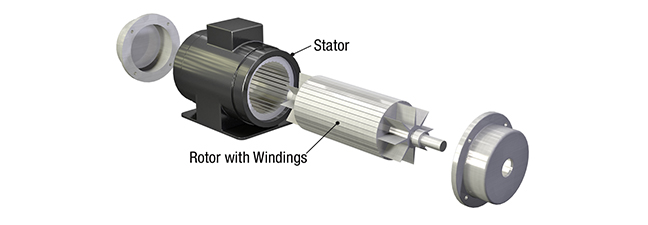
BLDC Motor Components
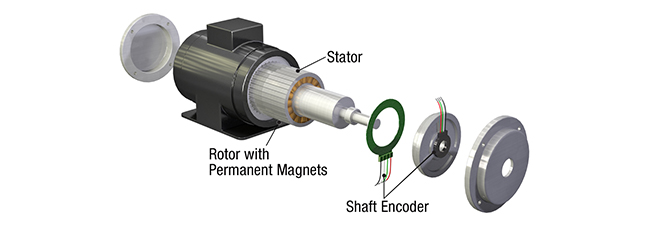
Alternatively, a BLDC motor replaces the windings on the rotor with a series of permanent magnets. These magnets create a magnetic field that interacts with the stator’s field and generates torque. However, rather than simply relying on the 3-phase power to generate a rotating magnetic field, a BLDC motor requires the stator’s magnetic field to be precisely controlled and aligned with the rotor position and its fixed magnets.
The stator field is controlled by a device that is all but identical to a VFD used with an AC induction motor but with one additional input; a shaft encoder attached to the rotor is required to help the motor controller keep the rotor and stator fields in proper alignment. The precise control of the stator’s magnetic field allows complete control of the motor including speed, torque and acceleration. A BLDC motor can generate full torque at zero speed. The motors are usually smaller for any given power level, and the rotor with permanent magnets is lighter than a corresponding induction rotor. Both of these traits allow a BLDC motor to respond much faster to changing load condition.
AC Vs. BLDC Motors
With AC induction motors being more common than a BLDC motor, why would operators select a BLDC motor for a pump application? There are several advantages and features that only a BLDC can offer, including:
- Higher efficiency: A BLDC motor reduces power consumption and heat generation.
- Precise control of torque and speed: A pump can respond rapidly to changes in system demand. The pump also has the ability to be “dead headed”, which allows the motor to generate full torque at zero speed. Additionally, the motor can generate constant torque. This allows the motor to be controlled to create constant pressure, which reacts to changes in a circulation system similar to a pneumatic pump.
- Lower rotor inertia: This results in considerably faster pump response to changes in system pressure than a similar powered AC induction motor.
- Smaller size: For any given power output, BLDC motors are typically smaller than AC motors, which also allows the pump to be smaller.
The improved efficiency of BLDC motors can be seen in the following graphs. Graph 1 compares AC induction motors to BLDC motors. Graph 2 shows the total electrical to mechanical efficiency of various types of circulation pumps.
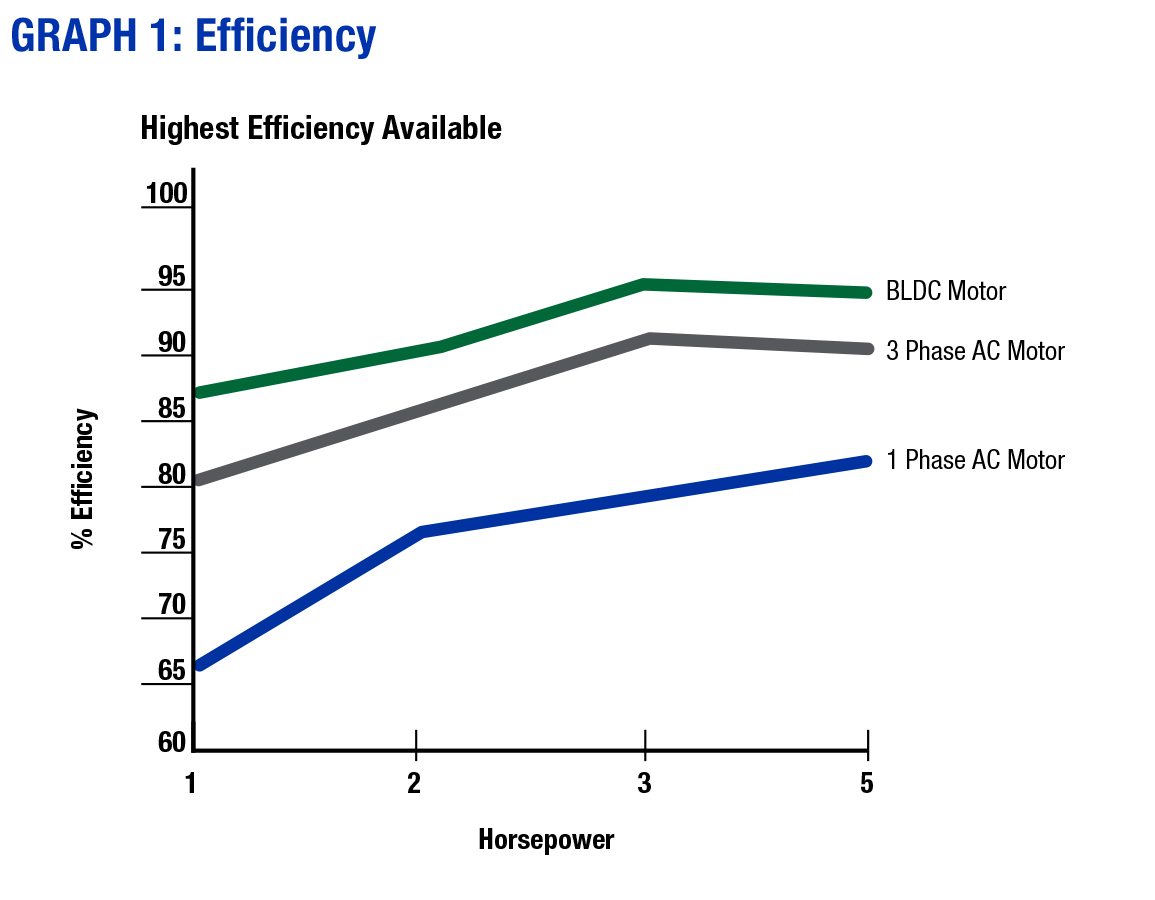
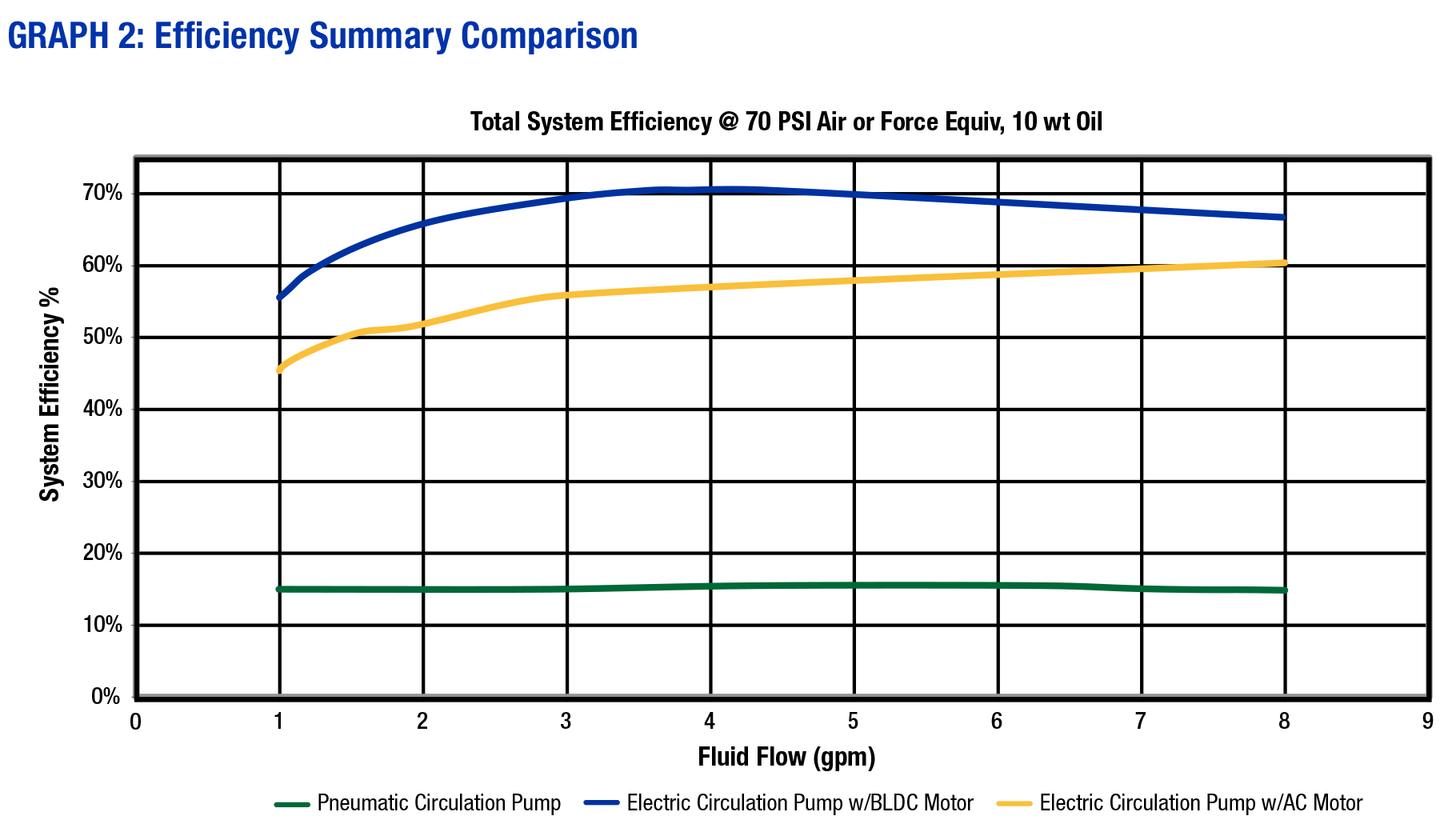
Why Simpler Is Better
In addition to the lower inertia and better torque control – which allow the pump to respond faster to changes in demand, precise pressure control and the ability to “dead head” the pump while maintaining pressure – a BLDC motor’s inherently fast response allows the mechanical connection to be significantly simplified.
Both types of motors require a method to convert the rotary motion of the motor to the linear reciprocating motion of a positive displacement piston pump. An AC induction motor’s relatively constant speed operation and slow dynamic response requires a complicated mechanical mechanism to accomplish this. For example, a cam or yoke arrangement may be used. Oftentimes, these devices are two to three times larger than the actual motor. They also have wear points and bearings that can easily break or wear out, and require costly maintenance or replacement.
Below is an example of an AC induction motor driven pump. Notice how the AC motor, gearbox and a rather large cam drive system are all separate, but are all required to covert the rotary motion to linear motion. The cam drive system has a multiple parts, which all experience constant wear.
In comparison, a paint circulation pump system may use a small BLDC, a two-stage gear reduction and a simple rack and pinion drive system to convert the rotary motion to linear motion.
To create the reciprocating action, the direction of rotation BLDC motor is simply reversed. With lower inertia and precise torque control, the BLDC motor makes this simple and efficient. In addition to pumps, this type of solution is common in other automation equipment such as ultra-precise high speed CNC machining equipment.
Motor Circulation
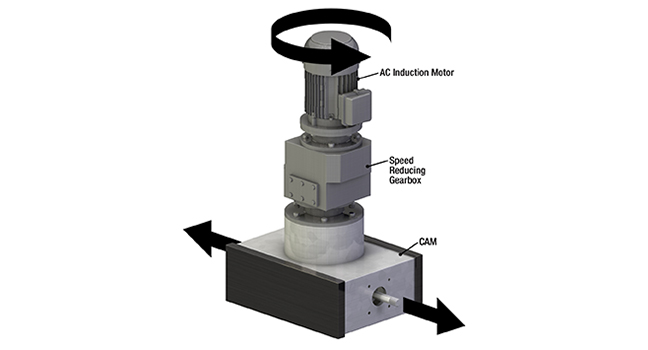
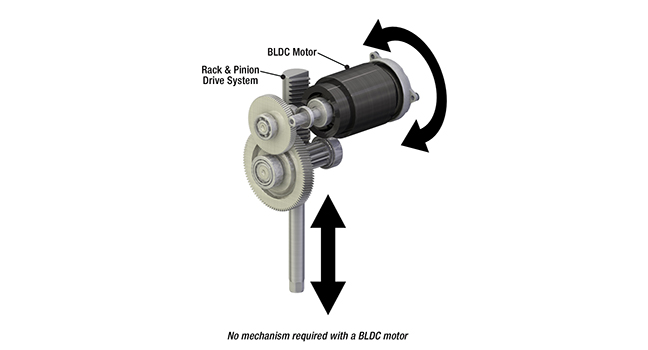
Conclusion
Implementing BLDC electric pumps in paint circulation systems allows operators to achieve optimal efficiency, control and performance. Additionally, with easy connection capability and quiet operation, BLDC electric pumps improve work environments, with quieter operation, allowing operators to remain near the pump to ensure continuous performance.
Related Articles
How to Lower Compressed Air Costs in Your Factory’s Paint Mix Room
More efficient agitator motors and pumps can cut energy bills – and improve the environment.
Achieving Sustainable Paint Operations with Electric Paint Mixing Pumps
One of the easiest ways to reduce energy consumption is with the paint circulation pumps in your paint mix room. Learn about advances in mix room equipment.
Finishing Solutions for Automotive Components
Get the flexibility to apply primers, base coats, and top coats with a single system.






